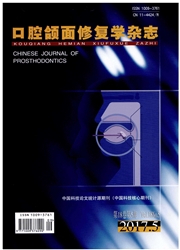

 中文摘要:
中文摘要:
目的:探讨人牙髓干细胞在体外成骨向分化潜能。方法:用免疫磁珠法分选人牙髓干细胞并检测其干细胞表面标志物Stro-1、CD29、CD34、CD44、CD45、CD90、CD105的表达。体外诱导人牙髓干细胞向成骨细胞分化,通过碱性磷酸酶染色和茜素红染色观察成骨诱导后细胞的成骨活性和矿化结节形成情况,通过real-time PCR分析成骨相关基因ALP、col I、RunX2、OC的表达,未成骨诱导细胞作为对照。结果:人牙髓干细胞阳性表达间充质干细胞表面标志物Stro-1、CD29、CD44、CD90、CD105,阴性表达造血干细胞表面标志物CD34、CD45。成骨诱导5d、7d、14d ALP染色阳性,21d茜素红染色仅诱导组可见明显钙结节形成,对照组为阴性。成骨相关基因ALP、RunX2和Col I mRNA在成骨诱导早期高表达,OC mRNA在成骨诱导14d表达开始逐渐升高。结论:经磁珠分选纯化的人牙髓干细胞在成骨诱导条件下可向成骨细胞分化,形成钙盐沉积和矿化结节,ALP、col I、RunX2、OC参与了成骨向分化的过程。
 英文摘要:
英文摘要:
Objective: To investigate the capability of human dental pulp stem cells(hDPSCs) on osteogenic differentiation in vitro. Methods: hDPSCs were purified by magnetic-activated cell sorting with Stro-1 and the phenotypes were analyzed with stem cell surface markers CD29, CD44, CD90, CD105, Stro-1, CD34, CD45. hDPSCs were treated continuously with osteogenic inductive medium for 21. Alkaline phosphatase(ALP) staining, the expression levels of ALP, osteocalcin(OC), Collengen I(ColI), RunX2 genes and alizarin red staining for mineralization at different time points were analyzed.The non-induced cells were used as control. Results: Phenotype analysis indicated that hDPSCs were positive for mesenchyme stem cell markers CD29, CD44, CD90, CD105, Stro-1, and negative for hematopoietic stem cell markers CD34,CD45. Compared with the control group, the ALP staining of the cells in induced group were significantly higher at day 5,7, 14 and only the induced cells could form mineralized nodes as shown by alizarin red staining on Day 21. The expression of the ALP, ColI, RunX2, OC genes were positive in induced group. Conclusion: Human DPSCs selected by Stro-1 have the potential of differentiation into osteoblasts under osteogenic culture and forming mineralized nodes. Osteoblast markers(ALP, OC, ColI, RunX2 etc) participated in the osteogenic differentiation of hDPSCs.
 同期刊论文项目
同期刊论文项目
 同项目期刊论文
同项目期刊论文
 Osteogenic response of mesenchymal stem cells to continuous mechanical strain is dependent on ERK1/2
Osteogenic response of mesenchymal stem cells to continuous mechanical strain is dependent on ERK1/2 Does Gonadotropin Releasing Hormone Agonists plus add-back therapy bring an aurora to orthodontic tr
Does Gonadotropin Releasing Hormone Agonists plus add-back therapy bring an aurora to orthodontic tr 期刊信息
期刊信息
